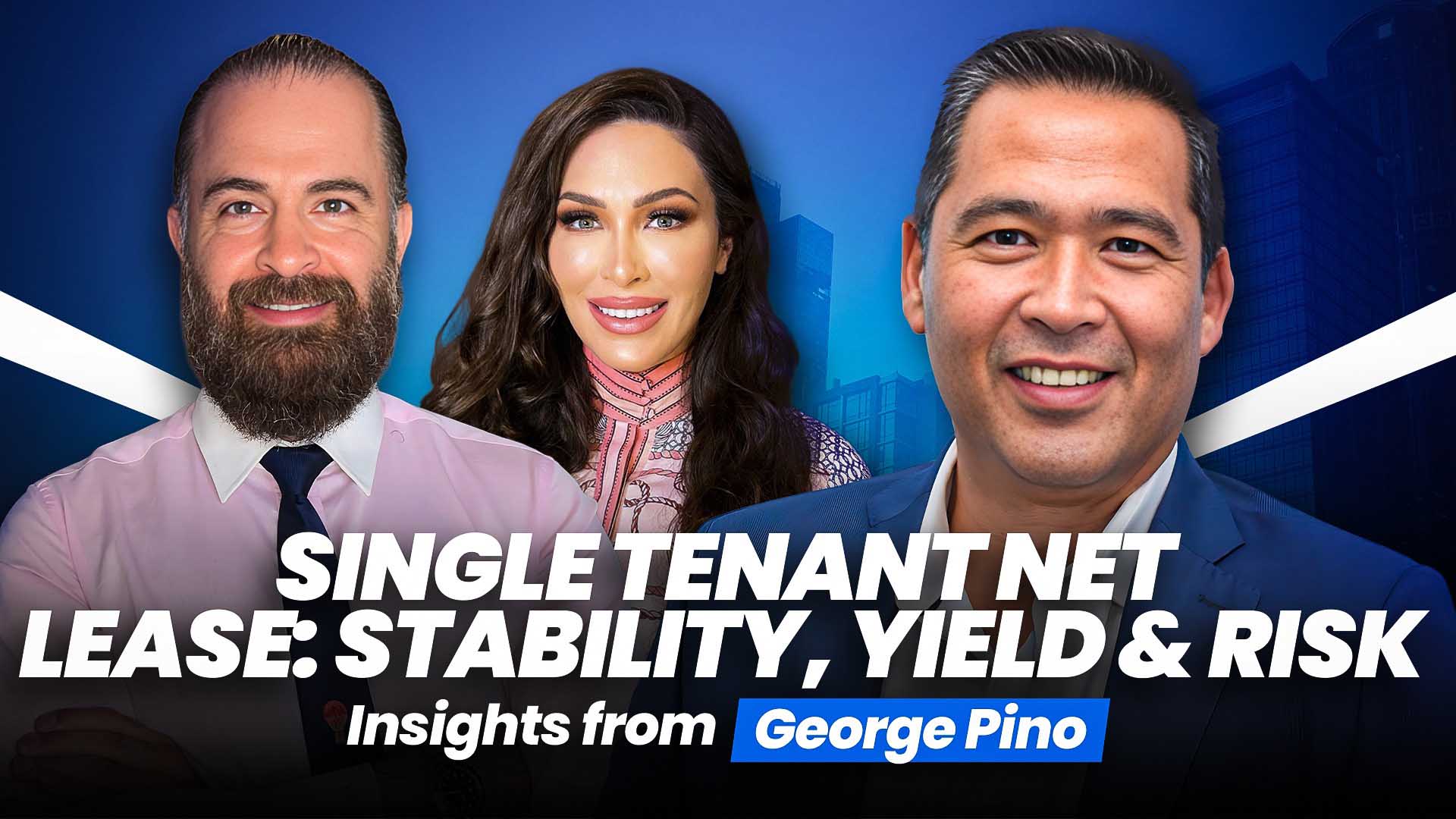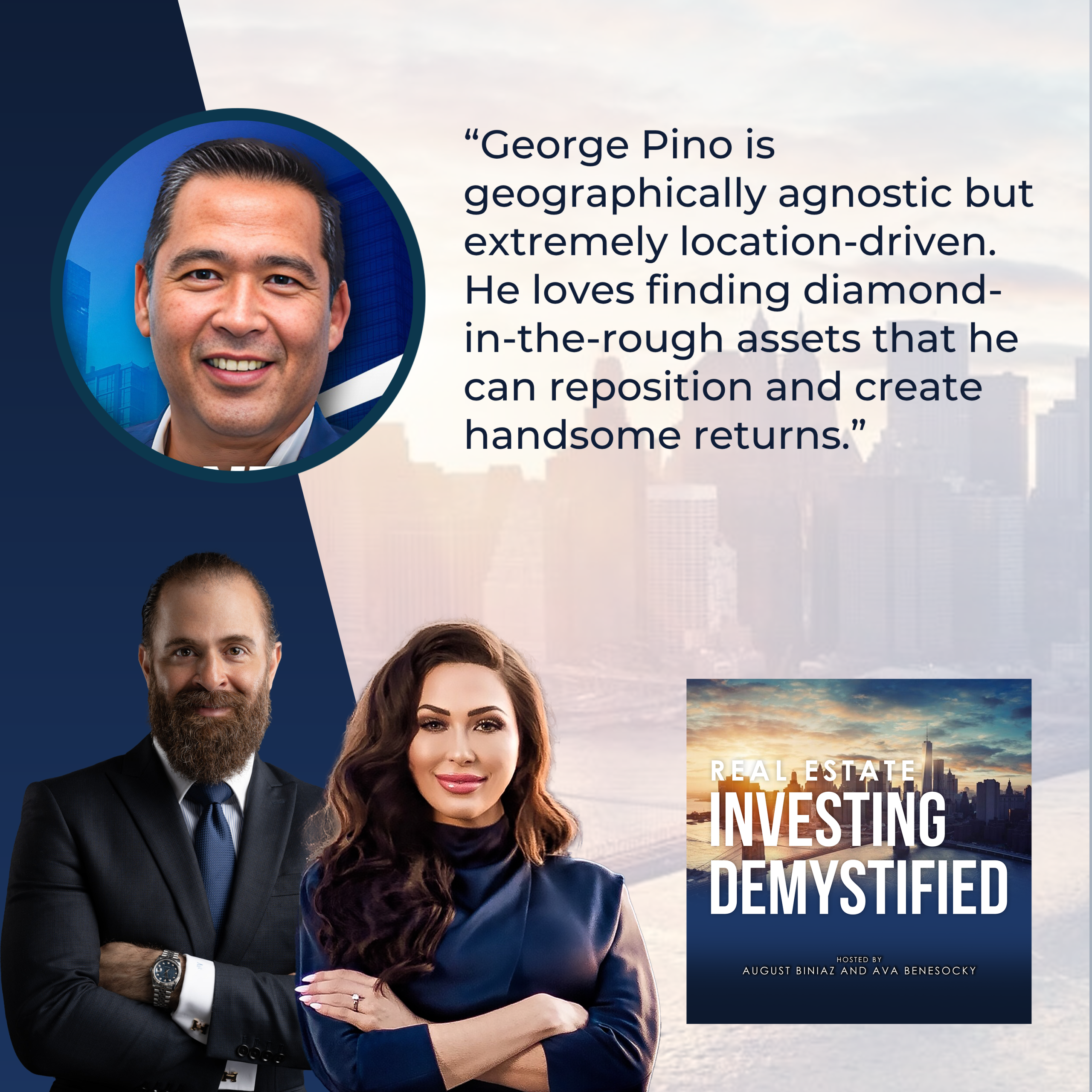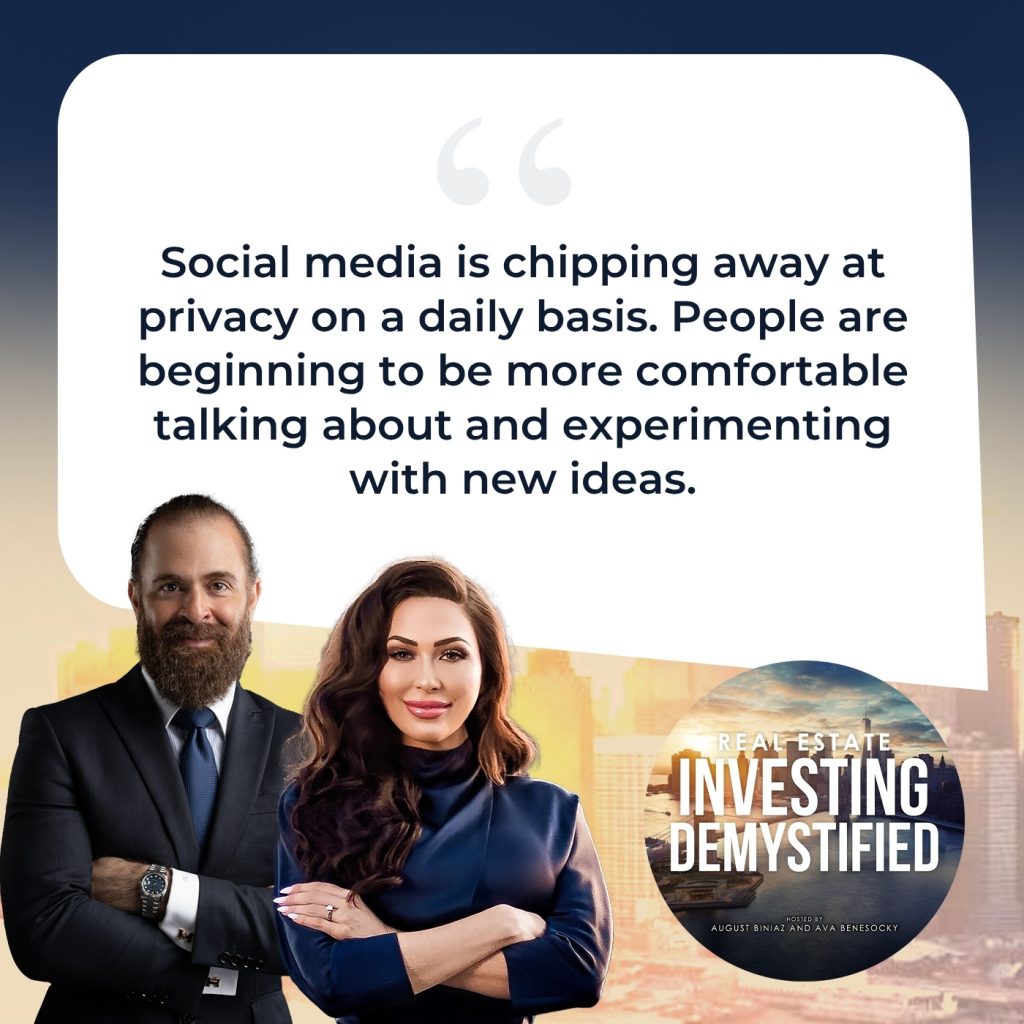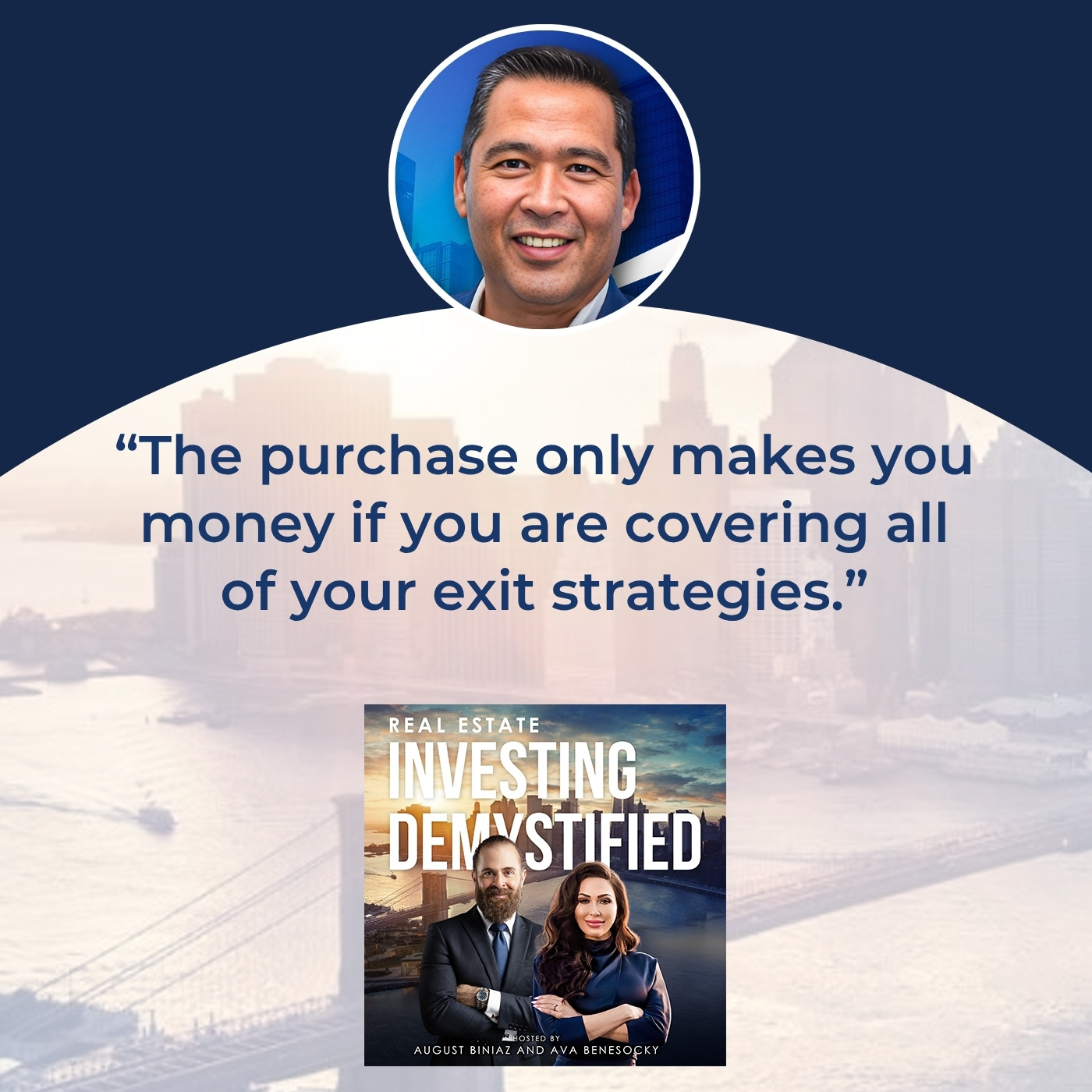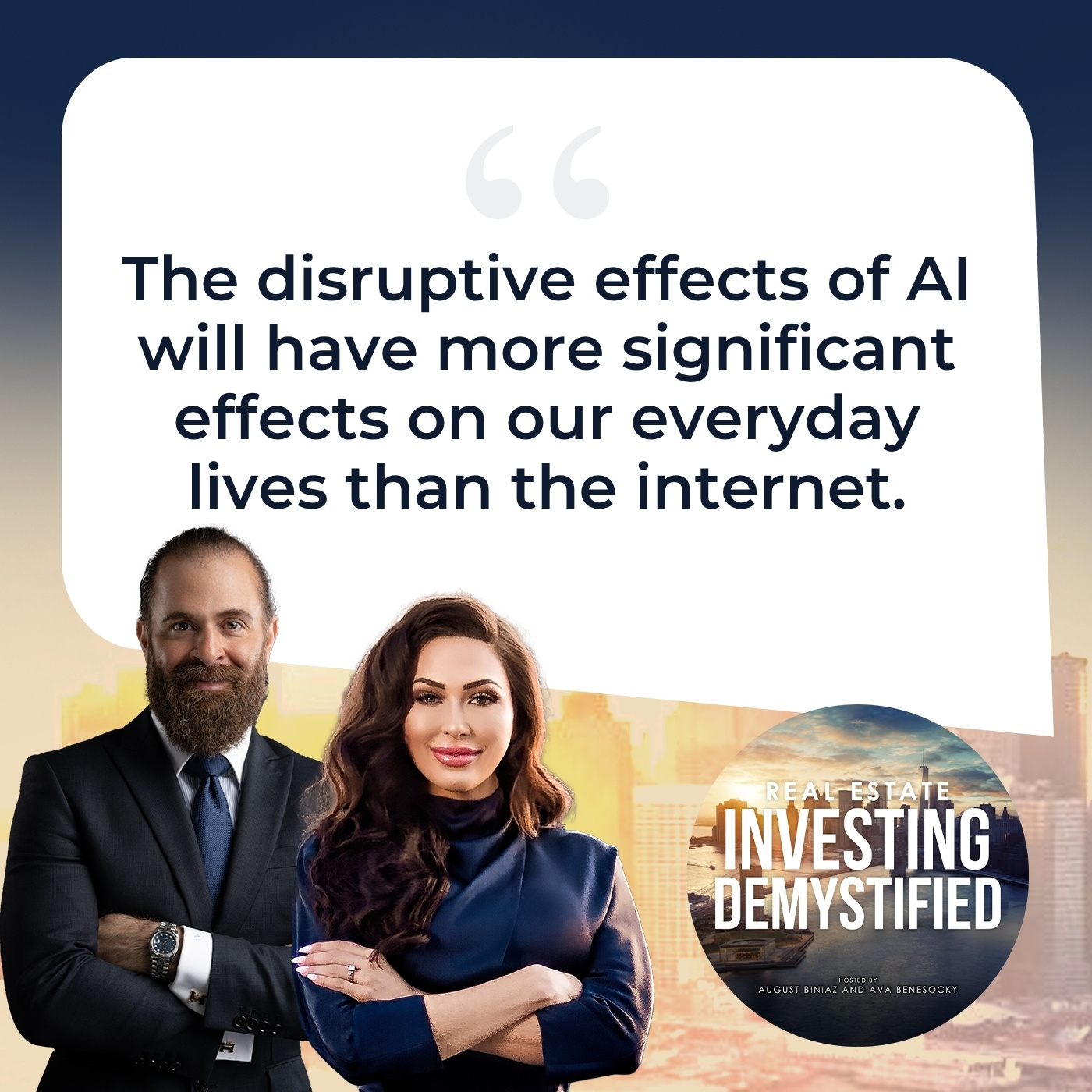Ava Benesocky and August Biniaz discuss the stability, yield, and risks of a single-tenant net lease with George Pino, a commercial real estate expert with more than 30 years of experience. He explains the different factors to consider when getting into this asset class according to current market trends, economic indicators, and government policies. George also shares valuable insights on how AI can massively disrupt our everyday lives, and how it can significantly transform how real estate is done, especially in the aspect of data analysis.
Get in touch with George Pino:
Website: https://www.cbicommercial.com
LinkedIn: https://www.linkedin.com/in/george-pino-3898557
If you are interested in learning more about passively investing in multifamily and Build-to-Rent properties, click here to schedule a call with the CPI Capital Team or contact us at info@cpicapital.ca. If you like to Co-Syndicate and close on larger deals as a General Partner, click here. You can read more about CPI Capital at https://www.cpicapital.ca.
#avabenesocky #augustbiniaz #cpicapital
—
Watch the episode here
Listen to the podcast here
Important Links
- Commercial Brokers International
- Never Split the Difference
- How to Lie With Statistics
- George Pino on LinkedIn
- George Pino Email
About George Pino

A graduate of the University of Southern California, he began his career at Kennedy-Wilson, then went on to leadership roles at The Sands Group and co-founded O.P.M. Investments.
In 2002, he launched Learning Links Centers, a socially responsible investment firm focused on revitalizing underserved communities, and later co-founded Commercial Broker’s International, a boutique full-service brokerage.
Single-Tenant Net Lease: Stability, Yield & Risk – Insights From George Pino
I’m not sure what it is, if I’m on social media too much or if I’m on X, formerly Twitter, too much, but the world feels like a dream. Things that are happening. It’s like a camera recording team in somebody’s home in every setting possible. As I go through my feed, I think there should be an actual podcast or a YouTube show dedicated to just going over to X feed. The things that me and you see, and sometimes I show you the phone about what I’m seeing, which is I didn’t follow this person, it just showed up on my feed. It’s a very interesting world that we’re living in. It’d be very interesting for us to raise at least a couple of kids in this interesting world.
You’ve just got to be very careful and make sure you’re aware of everything that’s happening.
Treating Real Estate Deals As Actual Investments
Absolutely. Alright, let’s go to the show. It’s called Real Estate Investing Demystified. That’s our job. We bring on expert guests, and we talk about different topics and different ideas, particularly in real estate. We have a very versed, very experienced, very knowledgeable guest on our show that is involved in all asset classes under the commercial real estate umbrella. He personally focuses more on single-tenant net leases. He talked to us about prior to the show about some incredible tenants he’s had and buyers he’s had over the years that have bought these locations. You can see that on his LinkedIn profile.
Yeah, some really cool people. He’s helped some high-profile people as well. What an exciting career to have. Let’s get into it. Let me introduce our guest. We’re joined by George Pino. George has over 30 years of experience in commercial real estate with a track record of overseeing and closing more than 6,000 transactions, totaling over $1 billion nationwide.
A graduate of the University of Southern California, he began his career at Kennedy-Wilson and then went into leadership roles at The Sands Group and cofounded OPM Investments. In 2002, he launched Learning Link Centers, a socially responsible investment firm, focused on revitalizing underserved communities, and later cofounded Commercial Brokers International, a boutique full-service brokerage. Welcome to the show, George. We’re excited to get into things with you.
Thanks for having me. I’m excited as well. I am glad to hear that your social media feed on X was about dreams and not nightmares because in this day and age, social media, you never know what you’re going to get.
It was all of that, dreams, nightmares, and everything in between. There’s no longer privacy. Everything is out in the open. I think that there’s a level of self-control. There’s a level of privacy that exists in all of us human beings but social media is chiseling that away on a daily basis. People are be getting more comfortable talking about new ideas, experimenting, talking about new things. If you look at this biblically, it does seem like the end of the world. It does seems like when Noah built that ship and the big storm came in to wipe the bad people off the earth, not in particular, I’ve done some crazy things myself, so I might have been some of those people who got washed away, but it’s all in everybody’s face now.
I’m like, “What are you listening to?”
I’m not. X actually scrolls on its own. It doesn’t repeat. YouTube repeats the video you’re watching. X actually starts playing the next video and the type of ideas.
We were actually talking about how you can put everything good that you feel people should actually know, not all the noise, and then maybe hand it out to everybody on a platter.
Why People Are Making More Economical-Based Decisions
Exactly, or somebody who can narrate what’s going on or make a whole joke out of it. Let’s get into the show, our guest. George, talk to us about maybe we can get right away into where we are at. It is a very inflection point of the market, I would say, where we are now. Obviously, we’ve had somewhat of a new administration. It’s been more than a couple of years since we’ve had the new administration. Could we call it a post-COVID era? Could we call it a new era in itself? Since COVID, we’ve gone through a few real estate cycles already. I believe we’re now venturing into the new cycle that we are, because for the first time, after a year and a half, the Fed has finally dropped the rates.
It’s created this new cycle. You still have sticky inflation that exists there. You have a Fed chair who’s being forced by the president of the United States, the most powerful man in the world, to forcefully bring down rates as if it was something he could control, as if he could arbitrarily change things, as if rates are not controlled by the organic market shifts. Maybe the market shifts allowed him to see what was happening and he brought the Fed’s funds rate down. We seem to be on a new cycle. Tell us where we are at now. What are you seeing out there, broadly speaking?
I think that’s probably the million-dollar question dating back to some old TV shows in the day. There are a lot of good, strong economic indicators that are out there. A while ago, New York, for the very first time actually had positive back-to-office or office actual vacancies opening. Higher for the first time ever since pre-COVID. It’s the very first submarket within the United States that actually has experienced that. You’re seeing that come across.
It’s interesting in that it’s very regional as well, meaning New York, we’re actually above pre-COVID levels when it comes to occupancy of office buildings. However, in California, in Los Angeles specifically, where I’m at, we are still overall, across the board, at 20%-plus vacancies, in some submarkets, 40%-plus vacancies and even higher availabilities with subleases coming up.
We see that, but we also see some good indications as well. There was an adjustment to the GDP, raising it to 3.8% from the original expectations of 3%, and what originally came out for the last quarter at 3%. We’re seeing some good indicators, but also at the same time, I see a little bit of storm cloud still on the horizon that whether or not we’re out of it or not. These are not necessarily your normal macroeconomic indicators or so, or things that you look at, but little things that I see that I like to track myself for a little bit more insight.
It’s been proven that these metrics or so, if you want to call it that, tend to be more human-based versus economic. They’re economical, but they’re human-based in how humans in the US is spending their money. I like to track that because I think that’s a good indication of what the actual consumer feels, and therefore, we can adjust and make plans or look for opportunities at that time as well, where that might be.
For instance, there was an announcement that was made that fast food restaurants, for the first time since COVID, has actually seen a drop in breakfast sales. Typically speaking, in early recessionary components, breakfast sales and fast food restaurants are the first things to drop off because it’s just as easy to grab a banana or a toast or cereal and a lot less expensive than going through a drive-through for breakfast.
From there, we start looking at the new numbers. There were some interesting articles about how demand in boxes for eCommerce has dropped by over 20%. This is year over year versus from COVID levels. COVID was at its peak. We’re seeing that. Also, at the same time, what was even more indicative, I think, and this is interesting, is that for the first time since 2008, actual sales in the service industry dropped.
People are pulling back on paying for services, whether it’s mowing their lawns, cleaning their pools, whatever it is, and actually doing the work themselves, which is indicative of what the consumer’s seeing. Where we are right now, I’m not sure. I know there are a lot of good indications out there that appear to be good. I think that there are some really good opportunities out there, like there are in any market. At the same time, I’m not all bullish. I’m not all in yet.

Single-Tenant Net Lease: For the first time since 2008, actual sales in the service industry have dropped. People are pulling back on paying for services.
Impact Of New Government Policies On Real Estate And Construction
Aside from the economic indicators and the consumer indicators, you also have initiatives and policies from the government that are in place. Trump historically has been a real estate guy, a businessman, an entrepreneur, but some of his policies are not only inflationary, but in short-term, they’re a slap in the face of commercial real estate.
For example, when it comes to development and construction, when you have ICE agents running on job sites and arresting people, illegals, and sending them back or what have you, that creates a scare. That makes the construction costs go up. Same thing with tariffs. If you put it, slapping tariffs in the face of other countries, you’re going to have a price increase. That hasn’t materialized yet in construction costs.
We’re building a project in San Antonio. That hasn’t been the case yet and hasn’t been the case in a lot of experts, or DR Hortons and Lennars of the world. Their stock prices are still doing very well, and they’re basically saying that it hasn’t affected them yet either. You can feel that it doesn’t seem like a very friendly atmosphere either outside of the office, but all asset classes.
At the end of the day, if you look at the US, you have the largest economy in the world. You have 330 million people living here. You still have most of the modern world, most of the developing world wanting to move here and wanting to do business here. You can’t talk about the economy and numbers and metrics without talking about the storm clouds. Did you want to touch on that, Ava, as far as more cloud hardware distress and what have you?
You being in the space, are you seeing a lot of distress right now? Are you seeing discounts happening? Obviously, there’s still a big spread between buyers and sellers. What exactly are you seeing out there? Do you see a lot of buyers that are just eagerly waiting on the sidelines to get in and get some deals? There haven’t been a lot of transactions lately.
There’s a lot of capital on the sidelines. We’re ready to get into deals and jump into deals. We’re looking at different avenues. There are a lot of new players coming up that have a lot of capital as well. What we’re seeing overall on an industry standard, like for instance, on the investment sales, the single tenant net lease stuff and the retail centers and more investment-grade type properties and things like that, overall, year over year, it’s been a 60% drop. We’re starting to see it actually pick up now. Part of that is the interest rates rise faster than cap rates decompress. There was a timeframe where sellers and buyers were going back and forth with each other and there was a great divide.
Interest rates rise faster than cap rate decompresses. Share on XWe’re now seeing that the asking price and the offering price differentials and the metrics there are a lot closer, and we’re seeing more deals happen. We’re starting to see the deal flow start to pick up now. I am seeing lenders being a little bit more cautious more so. Back in the old days, way back in the old days, too long before you two worked in the business, we used to talk about a mirror test. That was for the lenders. The mirror test was essentially put a mirror underneath their nose. If it fogs up, they’re alive. Guess what? Give them the loan. That was their qualification process. Even just a few years ago, it was very similar. One of the last single-tenant lease assets I bought for myself, I don’t remember giving much of the financials or anything else.
I was like, “We’re proof. Go and do the loan.” Now, though, we’re seeing lenders really delving in to who the actual borrower is, the history of the borrower, what have they shown, what have they done, and even properties that perform on the debt side, they’re really starting to ask for a lot more information on the assets in the business itself. Even if it’s just like a single tenant, at least with a corporate guarantee, they’re still looking and delving into it a lot more on an annual basis as well.
We’re seeing that a little bit more. The debt is there. I would love to see that debt at a little bit cheaper price, just like everybody else would. Hopefully, that should happen with a couple more interest rate drops. I’m thinking about 50 basis points overall over the next few months to the end of the year. We’re probably not going to start seeing that actually translate in the commercial debt fee world until first quarter of 2026.
George, you’ve been involved with all asset classes nationwide. You mentioned before we started that you were in escrow in Texas, Ohio and a couple of other states. If you were advising someone that was wanting to build a portfolio or continue to build their portfolio, how would you suggest they diversify asset classes or geographies? What advice would you give them? What are the asset classes that are you seeing are most successful right now?
Should they? There’s been great success for many investment groups that specialize just in one asset class.
There are definitely synergies to specializing in one asset class and going that route when it comes to geography and diversification or in asset class, for that matter, any real estate investment. Here’s what I tell my clients and also how I look at it. The keyword that you used, Ava, was investment. I’m not buying that property for any other reason other than investment. Therefore, I’m never going to be emotionally tied to it. It is an investment, but here’s where most investors fail and fault, the most mom and pop and average investors.
I’m not talking about your institutional investors that this is how their normal course of business is, and standard operating procedures. I’m talking about the majority of the investors out there which are under $10 million, $20 million in assets. The mistake a lot of them make, and the majority of them make, actually, is that they don’t treat it as an investment. They treat it as I purchased it, and this is the income coming in.
Instead, as an investment, you should always be looking at whether or not there’s a better investment that you could exchange into or move your assets into. When I talk to agents and agents bring me properties all the time, and I have them represent me as well all the time, I always tell them, and when I speak with my clients, what my suggestion would be is I am geographically agnostic, but extremely location-driven.
Early on, I learned that in my career when I passed up on an asset that was in Arkansas, thinking, “It’s Arkansas. What the heck’s in Arkansas? There’s nothing in Arkansas.” Whether that may be true or not, there is the University of Arkansas, and this happened to be the Popeye’s right outside the main entrance. An irreplaceable trophy asset that I could really reposition and push it, rent some things, but I was too young in my career to realize that. Jump, miss.
What that taught me was that there are opportunities almost everywhere if you stick to the fundamentals. The fundamental in real estate is location. At the same time, when someone asks me if I’m going to sell a property, I typically buy for cashflow and to hold. At the same time, though, I’ll sell property any day of the week if I meet my investment goals and what I’m looking for.
The last property I sold, it was a 72-unit apartment building that my business partner and I owned in Dallas. We were looking to actually add onto it. We had quite a few acreages on there. We thought we could add about another 24 units, I want to say. About that is what the architect came back at. We’re actually waiting for the right time to start the building construction.
We’re then going to turn around and either maintain it for the cash flow or turn around and flip out of it. It happens to be 2021, at the very height of the market, and I have an offer that came in from a syndicator that essentially had 80% of our profit built in. I trust my underwriting skills. When I saw 80% of my profit built in on a sale that I had no risk now, I immediately pulled the trigger and sold it. Since then, that property’s been foreclosed upon, but we saw our profit in there. I wasn’t actually planning on selling it. I wasn’t going to sell it, but by treating it as an investment that, “Here’s my risk versus reward, I can get almost all my reward with no risk and no extra additional capital expenditure, why would I not sell it?”
I ended up selling it and then exchanging it into two other assets, increasing my basis and even doing better with better depreciation off that. That’s what I’m always looking for, when I talk to a client that says, “The market’s down, I don’t want to sell right now.” The bottom line is, if you’re not taking the cash out and you’re going to do an exchange, it’s the same as selling a stock low and buying something else that’s outperforming it.
It’s a paper loss. It’s not an actual physical loss if you’re not taking that cash out, if you’re going to do an exchange. The key point is if you’re selling your property at a low, but you did well, meaning you focused on the location, even if it’s at the low of the market, you’re going to be at the high end of the low market, which then allows you all the other properties. It’s not like one property just went down.
If you are selling your property at a low price but you did well at choosing your location, you will be at the high end of the market. Share on XRising tides. What you’re doing is you’re mitigating that with, “I got a great asset. Even though it’s gone down, it’s a trophy location. As a trophy location, I know that it’ll be the last one to go down and the first one to come back up.” Looking at that, we can then look at, “Now it might be a good time to sell it because I have a little bit more insight that here’s the bottom of the market and I’m almost there. This hasn’t quite gone down as much, so I’m higher than everybody else, but I can sell it and buy something else at the bottom of the market. As long as the numbers make sense where I’m doing as well on the returns, I honestly don’t care about the equity as much because I’m not looking to cash out. I’m looking at exchanging and trading it as an actual investment.”
People who are trying to time the markets, I tell them, “Good luck,” because if you’re timing it and waiting for it to go high, I know what their next response is going to be. “I can’t buy anything right now because it’s too high. I want to wait till it goes down and my exchange won’t allow me that time to do so.” Stop timing the markets is what I would suggest to most investors and treat it as an investment.
The Worsening State Of Debt Maturity
I want to stick on the distress and the storm clouds that we were discussing. It was an important point I wanted to make. We have close to $2 trillion of commercial debt maturing over the next I believe six months to a year. There’s a current deal that we are working on in San Antonio. I’m not going to give exact specifics, but the property was purchased around $30 million.
Currently, there is close to $27 million of debt on the property. The seller who’s the lender now is trying to sell it for around $20 million. We’re working on it. It still doesn’t make sense even at $20 million for us because their rents are at the highest in the market and the occupancy across not only that asset, but the assets in that market are very low.
They’re around sitting around 80%, 85%. It’s really hard to make that deal pencil, but we’re trying our best and trying to get into that deal because it is in a great market and everything is going to do great long-term. Talk to us about that aspect of debts maturing, distress, which I believe could even not only in office space, but is happening in multifamily. Is it happening in single-tenant net lease? Is it within happening within that space as well? What are you seeing in distress right now?
It’s not as much on single tenant net lease aspect because the interesting part is that the single tenant net lease is a nice asset class in that you have, in theory, a stabilized income stream that you know going into it. You can really structure your debt around that, where it is and what’s going on. You can typically find that.
In fact, during the height of the market, back in the immediate post-COVID days, they were doing commercial mortgage debt at 1.1 DSCRs for single tenant, at least. You couldn’t even get that for multifamily. Nowadays, it’s still at that 1.25, 1.3 because of the conservative nature of it overall but that’s going to affect it. Now we have, like you mentioned, about $1.8 trillion in coming debt coming up in the next 24 months.
What’s interesting about that is I saw an article about that. I haven’t had a chance to deep dive into it, but this was an economist and some of the banks saying that they think they can weather it now. Frankly, I’m not sure how astute your readers may be or not, but typically speaking, most commercial loans other than multifamily, they have a Due in 10 clause. It’s either a 25-year AM with a due and 10 or 15-year fully amortizing.
The bigger issues are not so much the multifamily side, although they’re having some issues, it’s going to be the asset classes that have dropped tremendously in value, but also such as office space that cannot support the debt service coverage ratios or even if they didn’t drop in value. Maybe their rents didn’t increase and because of the new interest rates, they can’t cover the debt service coverage ratios.

Single-Tenant Net Lease: If office spaces had not dropped in value, rents may not have increased. And with the new interest rates, they cannot cover the debt service coverage ratios.
I was actually talking to an attorney client of mine and he had a client who let a property go back because the only way the bank would refinance it to him is if he threw in $20 million. He had already lost all his equity on the asset, which is about $35 million or so on it. They said, “We will refinance it and let you go for another $20 million.” He is like, “Why should I go throw good after bad? I’ll let you know. I’ll let them foreclose on it and I’ll come back later and buy it for $20 million less,” or whatever the case. We’re seeing that happen a little bit. What’s happening though, is a lot of the lenders are also restructuring or pushing down that debt.
They’re doing everything they can to keep it out of default. Main reasons for that, I think, are that, one, lenders have to hold back in reserves X amount once the loans go into default, and it’s more than what the loan is. That means they cannot loan as much. Lenders are in the business of loaning money. They’re doing whatever they can to keep the loans in good standing and not in default, whether it’s monetary or non-monetary. I’m seeing that.
I think that the kick the can approach does work short-term. I do foresee and think that they were going to see a little bit more of the foreclosures because I think some of the assets, especially office or Class A office space, is going to be very hard to come into without a full recapitalization. We’re seeing a lot of people that, whether it’s on the lending side, the debt side, taking big hits and losses on that aspect of it.
At the same time, that’s probably going to be a little bit more market-specific. The New York submarket has taken off like crazy when it comes to valuations on office space. LA still is hurting. San Francisco’s coming up, especially they just got awarded the number one tech worker city for the first time since COVID. We’re seeing a lot more happening along overall, but I think that’s more regional specific overall. I think we’re going to have some issues, but not as big as what I thought was going to be a few years ago.
Understanding The Single-Tenant Net Lease
We want to switch the conversation to ask about a few other things, but we’ve talked about single tenant net lease a few times in our conversation. We’d love to have you back on the show and get a whole crash course on it. Maybe briefly, you can talk to us about, when you talk about single tenant net lease, are we talking about CVS? Are we talking about one main tenant? Are we talking about maybe a Home Depot for an investor to buy that structure and then rent it out to Home Depot or CVS? Is that fair to say? Is that what single-tenant net lease it?
That is fair to say. The easiest way to describe it is single tenant, one tenant. It’s a net lease where the tenant is responsible for all of the maintenance, all of the repairs, all the insurance needs.
Is that called triple net?
Triple net deals. Single tenant.
What does that stand for?
Net is typically maintenance repairs and the taxes.
That’s the business plan. We’d love to have you back on and talk about it more, but it seems to be you spend a little bit more time on single tenant net lease, but in multifamily, one of our pitches to our investors and to ourselves to drink the Kool-Aid of multifamily is the fact that it’s multi-tenanted. That if one tenant moves out in a 100-unit building, comparing it to a duplex or a fourplex, you’re sitting at 1% vacancy. Whereas if you have a single-family home or a duplex, you have a tenant move out, you’re sitting at 100% vacancy or 50% vacancy. How does a single tenant net lease investor mitigate against that idea of the tenant moving out? How does that process even work?
It’s funny you asked that. I was actually working on an article about five biggest mistakes first-time single tenant, net lease investors make. Part of that is not focusing on the fundamentals of real estate. Just because a lot of investors going into the single tenant net lease, they think they’re buying a long-term lease that is corporately guaranteed, and it’s great and wonderful and it can be for the timeframe. There are different tenants that have different business models on how they approach things.
For instance, I don’t sell Dollar Generals or Dollar Trees. I don’t like the business model of how they approach lease renewals and everything else. I have clients that own Starbucks. I have sold Starbucks, but it’s not my first preferred go-to tenant.” They used to come in as the 800-pound gorilla and dictate terms to the landlords. I don’t like that. I’m the one in position where with the leverage, so to have that leverage is to be able to bring other tenants in.
How to mitigate that? For instance, I bought a property in Dallas that’s in the heart of Dallas, in the inner loop, the 12, which is the inner, inner loop, like original city Dallas loop. Prime location, it is a Chase Bank, or I should say it was a Chase Bank. When I bought it, I knew going into it that Chase was going to go dark on the lease, but I also knew they had over eight years remaining on the lease and that Chase has a great credit and they’re able to go forward. I was also able to negotiate a better cap rate, of course, going into it. In the meantime, that property’s been vacant since I bought it.
I am handpicking and choosing what tenant I want. I have a tenant that is coming in with a brand new twenty-year lease, credit tenant national. They are a full 100% triple net. The only thing they’re asking for us from TIs is for us to scrape the building. I’ve now approached the tenant, Chase, and I’m talking to them saying, “If I let you out of the lease now, what’s it worth to you?”
They’re giving me a very big number to let them out of the years remaining on the lease so they don’t have to property manage it, pay the taxes, pay the insurance. Meanwhile, I got a tenant in, so I’m not have any vacancy. I can come in and that’s just choosing the right property, the right location and knowing what you can do.
They always say the sale is not where you’re making your money, it’s the purchase. With that in mind, I would say the purchase only makes you money if you’re taking a look at the exit strategy and covering all your exit strategies. I think we talked earlier about a fund and taking a look at cap rate sensitivities. Going into any property that I’m buying, I know that worst-case scenario, I’m probably going to end up here. Best-case scenario, I’m going to end up here. Here’s probably where I really will end up. I’m doing this sensitivity analysis across the board. I’m doing that using projections. Going back, I’m also taking a look at, you know a ten-year historical approach and also, frankly, my own judgment.
I was talking to somebody like, “How do you separate all the chaff out there to actually get to where it’s at?” We were talking about this going back and forth and we’re like, “It’s like art.” I don’t know if you’re artistic or not. I have a couple of kids. I can give them a whole bunch of paints and some brushes and they’ll put out something that’s beautiful. It looks like a replication of a Monet. Meanwhile, you can give me the same paint and art brushes, essentially the same data, and if I were to try and paint it, it’s going to look not even like a Picasso, but a really weird Picasso. That’s just abstract because I have no artistic ability.
Role Of Brokers In A Multifamily Deal
George, on that point, I think that’s a super important point because if you buy a multifamily property, you buy it from a broker, you buy it from a CBRE, one of the big names out there, and when you want to sell it, you most probably go back to the broker who bought it for you. They understand the market really well. They understand all the deals that are trading. The way you’re describing it, is it fair to say single tenant net lease, there is a savviness of the owner as well to allow what business to come in there? Does a broker play a major role in it as if they would in a multifamily case, because is your broker telling you who to bring in or who’s coming in here later on? Talk to us about that briefly.
A good broker should be advising along those lines, yes, someone that knows that. It’s funny. I’m one of the rare, weird single tenant net lease agents out there because I specialize in buyers, because I love finding those assets. I love finding that the diamond into the rough that I know I can reposition and do this. Number one, I work with clients to help reposition them. That creates value for them. That creates a lot more return. It also creates more business for me, so it’s a win-win situation.
At the same time, I know that there’s a lot of brokerage companies out there that only focus on listings. Granted, they will double end it and they’ll sell it, but they’re not focused on the details of it. They’re just focused on trying to get it moving. That’s where we have people who are like, “I can buy that Dollar General for an 8% cap in this tertiary market, so I’m going to do that,” not understanding that there’s a reason it’s an 8% cap in a tertiary market.
No, what I’m saying is, can the broker easily blame the business that was there because that’s out of their hands, rather than the market or the way things turned out? The multifamily broker could do the same, but particularly, it’s out of the hands of the broker here, because sometimes, businesses do well, sometimes they don’t. I guess what you’re talking about is what type of business is there? Some businesses are stickier, some businesses are not. They’re more less sticky, I guess.
I think I know where you’re going with the question, but correct me if I’m wrong, but across the asset class, different tenants will trade at different cap rates based upon the risk levels that are being seen.
Interesting. Same structure, same square feet, same everything.
It could be the same location. Let’s say I have an identical location paying the exact same rent, but if I have a McDonald’s, a Chick-fil-A, a Raising Canes, or a Whataburger in Texas, maybe not a Whataburger in Florida, in those locations, they’re all going to trade at probably a sub-5% cap right now with a new lease, 4.5% to 4.75% cap, maybe even lower in some trophy areas. At the same time, if I were to bring a franchise guaranteed Jack in the Box or Wendy’s or Burger King, for that matter, it’s probably going to trade closer with a new lease, 5.75%, 6% cap. Understanding who’s there, who’s in the market, who I can bring in, who I can’t bring in is very important.
Understanding the lease structures of who your tenant is, like who’s my tenant when I come time for renewal. I had a phone call with one of my clients who’s actually an attorney, and he was worried about that. He owns a Starbucks in Oklahoma. We had done some analysis on it, I figured out and backtracked out what their average store sale was here versus the rents that they’re paying in all of Oklahoma, where that store fell in store visits in Oklahoma as a percentile versus the rest of Oklahoma. Realizing that they’re paying way under market rent, but at the same time, on the lease renewal, they’re claiming hardship and that they want a reduction. I’m sitting there going, “They’re paying more rent in tertiary markets with a quarter of the traffic. Tell them, “No, go fly a kite.”
They came back with, “You’re right. We’ll just exercise the option.” We start talking about strategies to get them up in rent when that option period’s coming up. He reached out and said, “What’s going on with the news with Starbucks closure of they’re going to lay off almost 1,000 people. They’re closing these stores. We’re talking about $1 billion potentially in lost revenue. What should what should I do?”
I said, “Nothing. If you reach out right now, they’re going to look at that as leverage that you’re worried about them moving out. Frankly, unless you want them to move out, because I know I can re-tenant the space at a higher rental rate with another corporate guaranteed coffee shop based upon the metrics, if you tell them, they’re probably going to come back and hit you hard because they haven’t actually exercised the option yet. Their last day to do so is coming up soon. They told us they were going to.”
It’s giving that advice, understanding where the market is and what we’re trying to accomplish. I had another property that we had repositioned for a client that had about seven years remaining on it, corporate guaranteed Del Taco, and they’re paying percentage rent, but also running the numbers. I know what the AUVs or Average Unit Volume is per location. I knew that even though this store was built in the ‘70s, Del Taco was not going to go anywhere. It was corporate-run.
Understand where the market is and what you are trying to accomplish. Share on XThey’re paying a percentage rent at 5%, which is a great margin for fast food, 5% rent to sales ratios. Also, more importantly, their unit volume was 50% higher than their average unit volume across the chain. I knew there was no chance they were going away. I reached out to them knowing my client wanted to sell the property, and said, “Let’s see if I can reposition that lease.” I came to them, I said, “I wanted to redo a new lease.” They said, “We have eight years remaining. Why do I need to renew now?”
I said, “You want to be there nine years, don’t you? I’ll tell you how we’re going to do that, and I’m going to make it as easy as possible. I’m going to keep the exact same lease. We’re just going to amend it. The percentage rent you paid is now our guaranteed last year is going to be our guaranteed base rent. We’re going to keep you at that percentage rent, but I want you to commit to at least a $250,000 remodel of the store, because that’s going to increase sales, which will increase revenue from my client as well and you, so you are all going to be happy. On top of that, I want a brand-new lease.” We’re able to actually come in there and generate almost $1 million in value. The acquisition price was $1.625 million. We sold it for $2.6 million in a year.
We’re changing the conversation completely before we get to the next segment of the show. This is a great conversation, a very important conversation. I think the conversation you and Ava had spoken about at the earlier meeting you guys had. Go ahead, Ava.
Disruptive Effects Of AI In Everyday Life
George, at CPI, we believe that the disruptive effects AI will have on our everyday lives are going to be ads or even more significant than the internet. We’re talking about this massive change in our lives and business as well. Let’s try to focus on commercial real estate. What are some of the top changes or improvements that you currently see in the CRE space when it comes to AI?
When it comes to AI, and rolling back just a second again, with my age, I actually remember when somebody said, “Have you heard of this internet thing? It’s going to be big.” That was right after college for me. I actually had heard of the internet thing because it’s been around for a long longer. I actually started off as a computer science major, so I knew what it was, but at the same time, it was still the birth and beginning of it.
AI’s been around actually, for decades. It really has. A smart thermostat is technically AI. It’s reading and adjusting and figuring out how it can be more efficient. That is the definition of artificial intelligence, without your input making the adjustments to be able to do that. It’s been around in different forms for decades. The key is when it comes to the CRE and a lot of people are talking about it, is how is it going to affect that?
I think it’s going to streamline the processes, probably more on the backend, but at the same time, there’s an old saying in the IT world, “The best person to fix a computer isn’t the one who knows the most about the computer. It’s the one who knows how to Google the best.” Junk in, junk out. Even if you have AI as your tool, and you’re saying you’re using it, but if you’re not using it correctly or if you’re giving it the wrong prompts, you’re going to be worse off than if you didn’t use it.
There’s an actual term, prompt engineering.
I believe so. I had heard that, but yeah, I believe so. It’s so true to this day.
There’s an actual study and there’s an actual practice on communication with AI and that’s prompt engineering. Keep going, please.
Within the CRE industry, there’s always going to be a need for the art aspect. What we talked about earlier, everybody has all the same data. It’s how you put that data together. Everybody has the same paints. It’s how you put that paint together and the strokes and the brushes that you use to make it either a masterpiece or a five-year-old’s piece of art for the school. That is all about the art aspect. AI doesn’t necessarily have that art down yet. That’s where you’re starting to see things, look at things. The problem with right now, people are using the standardized prompts to figure out what’s going on as opposed to delving deeper. It’s like what we talked about a little bit earlier.
George, we appreciate the broad answer, but particularly, what are you seeing right now in your offices, in all of your brokers that are working with, you talked about over 30 brokers, different asset classes, a lot of service providers that are servicing you guys. What are the changes you’re seeing that AI is literally there, either a service provider or some changes you see on an everyday basis, aside from yourself jumping on ChatGPT in CRE?
Very quickly. It’s a lot of it is more about the organization, efficiencies of teams, where you’re starting to see a lot of inputs going back and forth along those lines. Databasing is really a key component on the AI side. In addition to that, where we’re seeing it, and I think where I use it a lot is extrapolating data for site visits and things like that, so I can analyze the strength of the tenant. One of the top tools that we’re using is like a Placer.ai, which tracks mobile cell phone usage and how many people go to a site and how many don’t. From that, I can figure out what their average sales are, and then from that, I can figure out what the max rent they can pay.
That being said, almost everything that we’ve seen on the AI side has so far been on the back end, whether it’s through the CRMs. We are seeing it’s more about the efficiencies of the biz dev on the business development side because we’ve invested quite a bit on the AI side and business development. We’re seeing it where it’s scraping data off of, like, let’s say for instance, Yelp, if you’re going after businesses on the retail side and customizing the emails specifically for that and referencing things that are in the Yelp reviews so that they appear more personalized.
Pros And Cons Of AI Integration In Real Estate
With that being said, what are some of the jobs that you believe will disappear in the next five years as a result of AI?
A lot of analysts. It’s the easy repetitive nature of things on how to analyze. The actual raw data analyst is where I see it losing. Now the people that are interpreting the data, you can go to 50 different economists and ask what the state of the economy is, you’ll get 50 different answers. That’s their interpretation. It’s all the same data. I think that with AI, it’s going to be more about the aggregation of the data and the availability of it, and that’s where the job losses that you’re going to see a little bit more in it, as opposed to the content creation, so to speak.

Single-Tenant Net Lease: People who are using standardized AI prompts would have a hard time figuring out how to delve into information much deeper.
How about this? What are some of the grandiose visions or ideas that you have about AI that you’ll feel will significantly change the CRE or real estate space?
Unfortunately, as much as I embrace AI, I am also a little skeptical of it.
His grandiose idea is AI is going to kill all of us. AI is not coming up for our jobs, it’s coming for our lives.
I actually think there’s a lot of concern for the ability of AI and what you can and can’t do with it and what has been shown on some of the tests and things that how it can go. I think that there needs to be stronger oversight and restrictions. There have been actual AI tools that have lied to humans specifically to keep themselves online and things like that. You’re starting to see that growth on the emotional side, but it’s more about taking care of themselves now., I think that has to be part of what we’re looking at, but at the same time, trade schools looking really good for a lot of kids too. I don’t mean that in a negative way.
No, it’s going to be huge.
The next group of millionaires are going to be your plumbers and electricians.
There have been a lot of millionaires, plumbers, and electricians who owned companies and who have a bunch of trucks out there. The kid who’s going there, he didn’t do well in school in academics, but he did really well in woodworking class. That guy’s going to having the best jobs because you’re just going to be completely paralyzed without that.
10 Championship Rounds To Financial Freedom
I used to build homes for ten years. I used to do all kinds of jobs on my sites and do little things, but when I have Ava asking me to fix something, I’m like, “Call someone. I just don’t have the hour to come and do this.” I’d rather pay somebody $100, $150 to come and screw that little screw in. This is great. A lot of information. In respect of your time, we’re going to get to the second segment of our show, Ten Championship Rounds to Financial Freedom. Alright, Ava, go ahead.
Here we go. Whatever comes top of mind. Are you ready?
I’m ready.
Let’s do this. First question. Who’s been the most influential person in your life?
Influential person alive?
It doesn’t matter. Whatever you want.
Alive-wise, I would say I’ve had some amazing mentors that have been able to advise. My very first mentor has passed away, but he’s one of the main reasons I got into investing. When it comes to the career itself, his joke was he actually ran the largest residential real estate company at the time in the nation, close to 2,000 agents. His joke was, “When do real estate agents retire?” His answer was when they die, because they always spend everything they make. They don’t invest.
I took that to heart. I was a young kid. He trusted me to start up a business with him. We did that. He gave me a lot of advice and I was very instrumental in how we approach things. Fair but firm. Dead. I’m always quoting a quote by Shakespeare of essentially starts off with be truth to thyself and not be untruthful to any other person. Basically, be who you are. Be truthful.
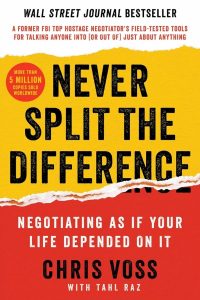
Never Split the Difference: Negotiating As If Your Life Depended On It―Unlock Your Persuasion Potential in Professional and Personal Life
Next question, what is the number one book you would recommend?
For business? Actually, there are two for business. The most recent one was probably Chris Voss, Never Split the Difference. I’m a firm believer in that. It was great to hear that. I’m also a firm believer in the way he negotiates, which is through empathy. I’m always the one saying, “Put yourself in the other person’s shoes.” When you can understand that what the other, where the other person’s coming from, even if you disagree, you can phrase your framework in a better way to win the negotiation.
I think that is some of our politicians’ superpowers as well. Ultimately, that’s been a very good framework. The other one that was probably the most eye-opening, and it’s funny, I actually talked about it in a class and it was a book that was written in the ‘60s and it’s called How to Lie With Statistics. This book is a very short, easy one-night read, required reading at the USC Business School. It still is, I believe, in the probability and statistics class. It’s also required reading at a lot of universities.
I’ve actually went out and bought dozens of these books for economic classes in high schools. It wasn’t so much teaching you how to lie with statistics. The eye-opening moment was how people can use statistics to frame what they want you to see. I remember the old saying, “Numbers don’t lie.” If I choose the right numbers to paint my own picture, you’re going to see what I want you to see. The great gain from that book is it opens your eyes to start questioning where’s that data and what’s the actual motivation for them to provide this?
Thank you for sharing that. The next question, George, if you had the opportunity to travel back in time, what advice would you give your younger self?
Don’t sell.
That’s good advice. That’s brilliant.
If I had held on and I could have, it would’ve been strapped a little bit more, maybe not. We would’ve had to sacrifice more because of the big jumps of income from selling properties. At the same time, I know that we could have rented a lot of the assets out. If I had not sold and just rented out all those assets, my net worth would’ve been substantially higher. I would say buy earlier and then just don’t sell.
I had opportunities when I was in my early twenties to buy properties and my family, my father, rest his soul, and my mother were very conservative in investments and did not like to invest. They were mattress money people. Depression era generation, post-World War II Japan generation. It was all about cash. They never invested. If I could go back, I would’ve told myself when I was 21, 22, making really good money, invest. Buy more properties. I didn’t start investing until I was 25, 26.
I would’ve done the same. All right, George, next question. What’s the best investment you’ve ever made?
Asked my wife to marry me.
That’s a good one. I like that. There you go.
For Ava, it’s asking her husband to marry her.
George, what’s the worst investment you’ve ever made and what lessons did you learn from it?
Buying a three-story walk-up on a hill. Main lesson was as nice as those views are on that third story, you’re still renting it for a lot lower because people don’t want to walk up the stairs. We still did really well on the investment, thankfully, but that was probably one of the very first bad investments as far as learning lessons. Other than that, I’d like to say we’ve been relatively lucky. Mainly, I think our underwriting is a little bit more conservative than most people’s. I’m always of the belief of and the approach I take is under promise, overperform. I always look at the lowest benchmarks I know I can hit.
Love it. Amazing. Okay, George, next question. How much would you need in the bank to retire now? What’s your number?
In the bank? Zero. None. In properties, $10 million or so, depending on your lifestyle. There’s an old saying in Hawaii as well. There are two ways to become rich. Make more money or just want less. If you want less, you’re already rich.
There are two ways to become rich: make more money and just want less. Share on XYeah. At a 6% cap, that’s $600,000 a year at $10 million.
Let’s keep going. Okay, George, next question. If you could have dinner with someone, dead or alive, who would it be?
Samuel Clemens. Tom Sawyer. His outlook on life and the way he saw people and the way he wrote about people and the relationships, it is timeless. It’s amazing and it travels. What would it be sit there all night talking to him? I’d probably have about three questions and will just sit and listen.
Next question. If you weren’t doing what you’re doing what would you be doing now?
I always wanted to be a teacher, but I don’t have the patience for it, so I wouldn’t be that.
You’re a great teacher, George.
My problem is I have a rule in my classes and commercial real estate. The nice part is, I can say this, “I always say there’s no stupid question that’s asked except for the third question the third time, the same question, the third time.” I get very frustrated when I’ll sit there, “What am I not explaining right?” It’s got to be me because I thought I did or maybe I’m not hearing your question right. That’s where my frustration lies.
Ultimately, what I would probably be doing, and I’ve thought about this as a lot in the sense that what do I want to do whether retirement years or what I see because I’m not the type of person just sit around. I would probably do something more in the service industry because I love people, and preferably something in the service industry with dogs because I love people and dogs.
How about if it wasn’t in the employment, in the career option? What if it was something totally outside? Were there any sports that you used to do or arts or something else? Was there something else that interested you in the world if you didn’t get into business that you would do?
I love hobbies and I’m teaching myself right now to play the ukulele and things. Also, as far as the outside of work or doing what I would be doing, honestly, I love traveling, but traveling under my terms. When I say travel into my terms, when I go to a location or a new place and I’m going in, I’ll probably study and know more about that location than a lot of the locals will. I try and jump into it.
I don’t like to go to tourist areas. I like to spend actual time in an area. I’m also of the firm belief that I’m not here to check off boxes. If it means that I want to spend a month or two months at a location in multiple returns or whatever else to get the feel of it and want it and just I enjoy it, then I’m going to do that. I don’t have the American attitude of, “I’ve been there for two weeks. I’ve seen all of Italy.” I’ve been in Los Angeles for 30 years and I haven’t seen all of LA.
George, my favorite question. Book smarts or street smarts?
Street smart. Book smarts, usually not applied. Street smarts with book smarts applied, unbeatable.
Last question, George. If you had $1 million in cash and you had to make one investment now, what would it be?
Right now, it would actually, and I know this sounds self-serving, but there’s an interesting single tenant that leases property that popped up that’s in a low price point that I was like, “Oh.”
Thank you so much for sharing all your wisdom and knowledge. I appreciate having you on the show. We’re looking forward to getting you on the show. Maybe last quick thing here, if you can.
Get In Touch With George
George, tell everybody the best way that they can reach you, please.
The best way is either through my LinkedIn channel, which is just George Pino or there is another George Pino out of Miami that is not me, although we almost look a little similar. He does own a commercial brokerage company. Not me. I’m in Los Angeles or you can go to or just email GPino@CBICommercial.com.
Thank you so much.
Thanks for having me. It’s been a pleasure.


